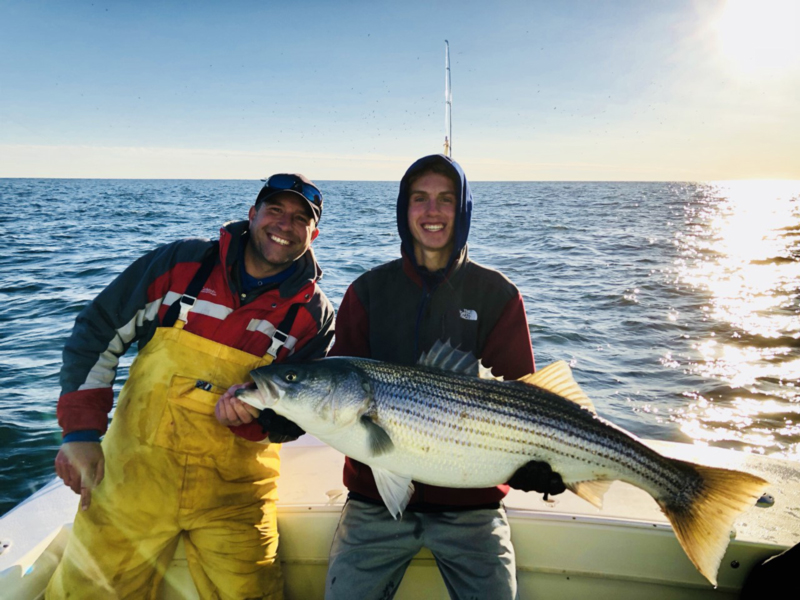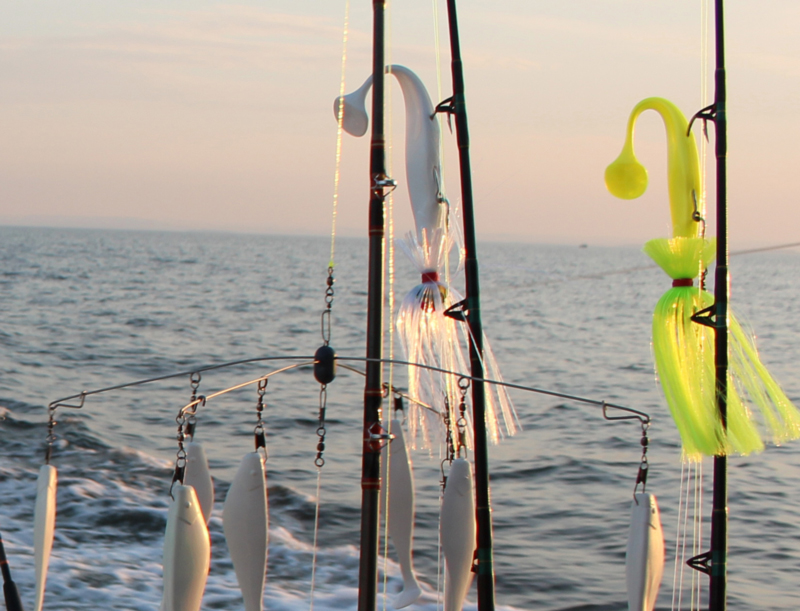Winter striped bass fishing in the open Atlantic requires fortitude, motivation, and for most anglers, plenty of hot coffee. Yes, in the areas these fish range during this time of year it’s going to be cold out there, people. The rewards, however, are more than worth the temporary chill. The ocean-run striped bass that decide against hooking a right hand turn at the mouth of the Bay to spend Christmas in the Chesapeake (darn!) are big fish, including large numbers over the 40-inch mark. Whether or not you can target them, however, depends on two factors: exactly where they decide to spend the winter months, and how far off the beach it is.

Rockfish Off the Beach
The general area the stripers will be found can be anywhere all the way from the Delaware coast down to North Carolina’s waters, though in recent years few have been travelling south of Virginia. It’s fairly easy to get a read on the general area in the Mid-Atlantic region where the main body of fish is thanks to fishing reports and social media. The bigger question, however, is whether or not they’re swimming within three miles of the beach. Outside this zone is federal Exclusive Economic Zone (EEZ), where not only keeping but even catch-and-release fishing for striped bass is prohibited, according to the Atlantic Coastal Fisheries Cooperative Management Act.
Where they’ll choose to go is a crap shoot. Some years hordes of big stripers can be caught within spitting distance of the beach, and some others they may decide to head for the shoals 10 or 12 miles off the coast. There’s just no way to predict exactly where those fish will end up. We can tell you for sure, however, exactly how to catch them if they’re within shooting distance.
Light Tackle Striper Action
Light tackle aficionados looking to hook into the fish of a lifetime have a good shot using the same sort of gear used for jigging in the Bay, though it should naturally be up-sized to account for the size of the quarry. This isn’t a time to skimp on gear size, either, since trophy-sized fish will be released (the entire coastline is under a slot limit) and thus fight times should be minimized to avoid tiring fish to the point of exhaustion. Medium-heavy rods and 20-plus pound-test mainlines with 30-pound leaders on 4500-series and larger reels should be considered bare minimum, with heavier gear often opted for. Jigs get up-sized as well, with Bay-standard six- and seven-inch plastics traded in for 10-inchers.
When it comes to jigging for oceanic stripers the single most important tool you’ll come to depend on are your binoculars. The action almost always comes when birds are spotted, and while you might spot a flock of working birds from up to a mile away with the naked eye, binoculars will extend that range to several miles. If you want to have the best chance of success you’ll get gyro-stabilized super-binocs with 14X or better magnification, which can be used to spot birds at ranges of seven or eight miles.
Fair warning: head out into the Atlantic and cruise up or down the beach using binoculars, and there will be days when you accomplish nothing beyond burning gas. It happens. But you’ll also have a decent shot at hooking into a once-in-a-lifetime rockfish.
Trolling for Ocean Run Stripers
Most seasons the majority of the stripers caught in the ocean will be caught trollers, especially when flocks of birds and breaking fish don’t give the school’s locations away. The fish do move around, and it can be difficult to locate them on any given day without covering some water. Trolling allows you to do so. Spreads consist of parachute-style lures in the six- to 12-ounce range rigged with nine-inch plastic shad trailers tied into tandem rigs. Umbrellas trailed by either one or two hook-baits are another standard offering. Deep-diving lipped plugs are popular in some areas, and old-timers often reach for big bucktails (again dressed with plastic shad or possibly pork rind for die-hard traditionalists), and large spoons like the classic Tony Acetta #21 Pet.

A standard boat-spread of six to eight lines can be enhanced with planer boards. Using planers on the open ocean can be a bit risky, though, as even the largest and most stable boards can over-turn in big waves, creating a multi-line tangle of epic proportions. As a result, savvy anglers won’t deploy the boards unless it’s relatively calm.
More info on trolling for oceanic stripers in specific can be found at FishTalkMag.com in the article “Trolling for Winter Ocean Stripers,” by Coastal Correspondent John Unkart (just plug “trolling for winter” into the search box in the upper right corner of the screen).
Fishing with Eels
When the winter stripers relate to structure which can be pinpointed, such as a specific shoal or series of shoals, a wreck, or the pilings of the Chesapeake Bay Bridge-Tunnel, fishing with eels is often a killer method of taking big stripers. (Note: regulation-wise the CBBT is considered inside the Chesapeake, so Bay regs apply. At of the time of this writing striped bass caught at the CBBT between 20 and 36 inches can be kept through December 31, but fish of any size must be released as of January 1. These regulations change on a regular basis, so check before you go).
As is common when eeling for rockfish, rigging consists of a simple three- to four-foot leader of 40- or 50-pound test terminating in an 8/0 or thereabouts circle hook, which is pushed up through the eel’s lower jaw and out through its upper jaw. In-line weight is added as needed, in some cases a float is used to keep the eel at the proper depth, and the eel is drifted through the target zone.
Drop a slithering eel in front of a rockfish and it’ll have a tough time turning it down. The down-side, however, is that the fish do need to be highly concentrated and/or focused on structure for this tactic to be effective; drifting eels aimlessly about in the ocean when the fish are scattered around somewhere off the coast isn’t a recipe for success. Putting these two factors together, eels make for a great backup plan for both light tackle anglers and trollers heading for the open ocean. Grab a dozen before leaving the dock, and if you spot fish on the meter along the edge of a slough or atop a shoal but have a tough time getting them to bite, send a few eels down to tempt ‘em.
So: are you ready to layer up, fill the Thermos with hot coffee, and hit the ocean for some stripers? For anglers living along the Mid-Atlantic coast, this can be your ticket to red-hot angling action during the coldest months of the year.
Striper Slot Limits
The entire DelMarVa coast is under a slot limit for striped bass year-round. Since these rules and regs are under constant adjustment and there’s a time-delay between this writing and when FishTalk comes out in print, we suggest looking up the current regs for your state waters before shoving off the dock.
Delaware: One fish per person per day, above 28 inches and below 35 inches.
Maryland: One fish per person per day, above 28 inches and below 35 inches.
Virginia: One fish per person per day, above 28 inches and below 36 inches.
Virginia Bay (including the CBBT): One fish above 20 inches and below 36-inches can be kept through December 31; fish of all sizes must be released as of January 1.